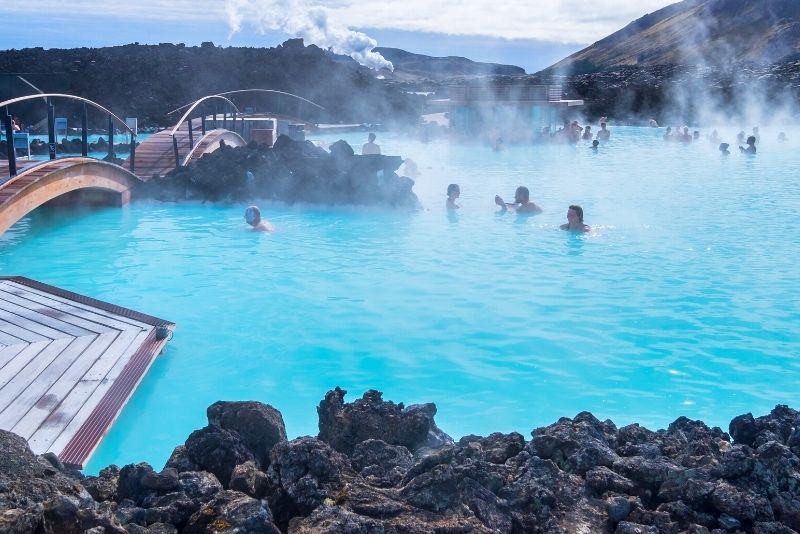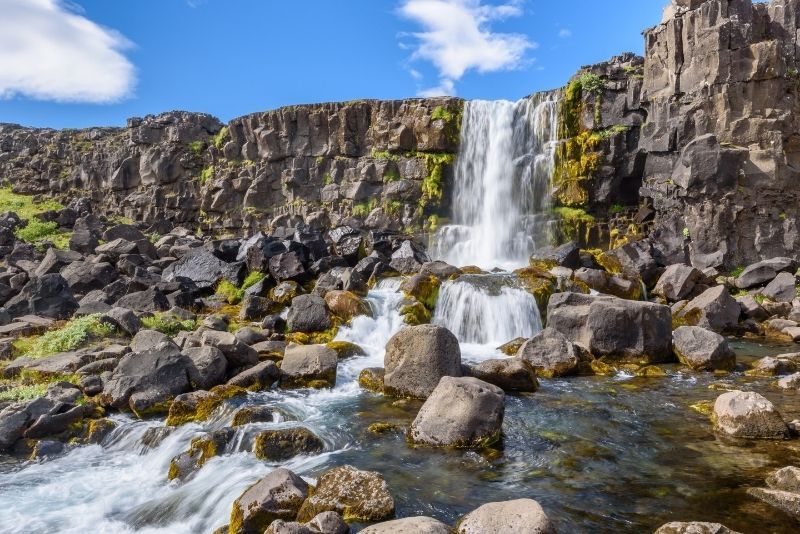Golden Circle: Day Trips and Tours from Reykjavík
Starting in Reykjavík, the Golden Circle takes travelers on a scenic loop through majestic landscapes featuring volcanic craters, jagged mountain peaks, powerful waterfalls and bubbling geothermal pools.
This route from the city includes three of Iceland's most spectacular geological sites — Thingvellir National Park, Gullfoss Waterfall and Geysir Geothermal Area. All of these landmarks hold their own magical charm, sure to thrill and excite you on a Golden Circle day trip from Reykjavík.
Starting in Reykjavík, the Golden Circle takes travelers on a scenic loop through majestic landscapes featuring volcanic craters, jagged mountain peaks, powerful waterfalls and bubbling geothermal pools.
This route from the city includes three of Iceland's most spectacular geological sites — Thingvellir National Park, Gullfoss Waterfall and Geysir Geothermal Area. All of these landmarks hold their own magical charm, sure to thrill and excite you on a Golden Circle day trip from Reykjavík.

(0/24) checking Musement...
Starting in Reykjavík, the Golden Circle takes travelers on a scenic loop through majestic landscapes featuring volcanic craters, jagged mountain peaks, powerful waterfalls and bubbling geothermal pools.
This route from the city includes three of Iceland's most spectacular geological sites — Thingvellir National Park, Gullfoss Waterfall and Geysir Geothermal Area. All of these landmarks hold their own magical charm, sure to thrill and excite you on a Golden Circle day trip from Reykjavík.

Here's all you need to know about Golden Circle, one of the most exciting day trips from Reykjavík.
How to get to the Golden Circle from Reykjavík?
The Golden Circle loop begins in Reykjavík and spans 300 kilometers across the south of Iceland.
From Reykjavík to The Golden Circle by car
The first destination on any Golden Circle journey is usually Thingvellir National Park, which takes approximately 40 minutes to drive to from Reykjavík. Leave the city and follow Vesturlandsvegur/Þjóðvegur 1. Just after Mossfellsbaer, you'll turn right at the roundabout to follow Þingvallavegur to the national park.
Guided tour to the Golden Circle from Reykjavík
Alternatively, make the jaunt to the Golden Circle via a guided tour, and have everything pre-arranged for you. You'll benefit from a convenient hotel pickup between 8 AM and 10 AM, and excursions usually last between 8 and 11 hours.
What is the typical itinerary?

After a hotel pickup in the morning, you’ll waste no time heading out toward the Golden Circle. The first destination en route is usually Thingvellir National Park — Iceland’s only UNESCO-listed destination — where you’ll view the exact spot where the tectonic plates separated. You may also stop to learn about the Icelandic parliament that was formed in the park in the 10th century and assembled for the following 800 years.
Continuing on your Golden Circle day tour, you’ll board your bus and travel to Gullfoss Waterfall. Here, you can enjoy the trails surrounding the falls, listen to its soothing roar and snap a breathtaking shot of its cascades. From there, you’ll drive to Geysir Geothermal Area to witness the rare sight of water being spurted from the ground at alarming speeds. There are only 1,000 geysers on the planet, three of which can be found in this geothermal region.
Some Golden Circle day trips journey back to Reykjavík after this, while others continue on to visit other sites. These may include Kerid Volcano, the Blue Lagoon or Friðheimar Greenhouse.
What kinds of tours are available?
A day trip to the Golden Circle follows a picturesque loop around the southwest of the country. You can choose a tour that also encompasses other highlights of this corner of Iceland.
Guided tour to the Golden Circle from Reykjavík
On this day trip to the Golden Circle, you’ll travel first to Thingvellir National Park — known for several remarkable events. Here, you can see firsthand where the North American and Eurasian tectonic plates were forced apart in the 18th century.
You’ll also be able to visit the site where the Icelandic parliament was formed in 930 A.D. before moving on to admire the colossal cascades of Gullfoss Waterfall. Lastly, see the spot where Geysir shoots water out of the ground up to 70 meters high several times a day, as well as its more active neighbor — Strokkur.
Day trip to the Golden Circle plus Kerid Crater and the Blue Lagoon from Reykjavík

On your Golden Circle day tour, you can also choose to visit the Kerid Crater and the Blue Lagoon. After being awed by the three wonders that form the Golden Circle, you’ll continue on to see the red slopes and contrasting turquoise crater lake of Kerid Volcano.
You’ll learn about the unique way its caldera was formed and how geologists can tell its age by the volcano's appearance. Finally, rest your weary limbs in the healing thermal waters of the Blue Lagoon before returning to Reykjavík.
Day tour to the Golden Circle plus Friðheimar Greenhouse from Reykjavík
Alternatively, you can learn about Iceland’s unique way of cultivating crops at Friðheimar Greenhouse after exploring the natural delights of the Golden Circle. Here, you’ll discover the ways in which farmers harness the geothermal heat produced in the Frudir region. They then use this energy to grow perfectly ripe and juicy tomatoes year-round, despite the inhospitable climate outside.
How much does a day trip to the Golden Circle from Reykjavík cost?
Basic Golden Circle day tours cost between US$60 and US$80 per person, which includes round-trip transportation, and a professional guide.
Golden Circle excursions that include Friðheimar Greenhouse cost approximately US$70 per person.
If you wish to add the Kerid Volcano and the Blue Lagoon to your itinerary, you’ll pay between US$130, and US$205 each. Tours on the higher end of this range include all entry fees.
What will you see and do?
Thingvellir National Park

Located in an area of great geological and historic importance, Thingvellir National Park offers visitors a glimpse into the region's past. The park’s biggest claim to fame is as the site where the North American and Eurasian plates separated after a powerful earthquake in the 18th century.
These plates are still drifting apart at a rate of 2.5 centimeters per year. Snorkelers can slip into the Silfra Fissure to view the two plates, while divers can get up close to touch them, and feel as though they are a small part of this monumentally historic event.
Geysir Geothermal Area
The main attraction of the Geysir Geothermal Area is Geysir itself — also known as Great Geysir — which was the first of its kind to be discovered on the planet. This natural hot spring shows signs of being active for over 10,000 years and has been known to shoot water as high as 70 meters into the surrounding landscape. Geysir fell dormant during the 20th century, however, an earthquake triggered it to become active again in the years since.
The Geysir’s activity has slowed down over time and currently spurts water only two or three times per day. Visitors on a Golden Circle day tour can get their hot spring fix at the neighboring Strokkur geyser instead, which erupts every 7 to 10 minutes and is located just 50 meters from Geysir.
Gullfoss Waterfall

A double cascade of waterfalls, Gullfoss streams into a glacial river flanked by dramatic basalt cliffs on either side. The raging torrent of the falls can be heard from several kilometers away, while the powerful spray creates fog and rainbows in its mist.
At over 30 meters high and more than 70 meters wide, Gullfoss is undeniably impressive. The falls has been featured several times in pop culture, the most notable of which is during the TV series “Vikings.”
When is the best time to visit the Golden Circle?
The best time to plan a Golden Circle day trip is during the summer months — between May and September — when the climate is mild. During this time, you can expect temperatures to range between 9 and 13 degrees Celsius.
If you would prefer to see the extremes of Iceland’s dramatic landscapes, visit during the winter months when Gullfoss Waterfall is at its most powerful.
Travel tips
- If you choose to embark on the Golden Circle route during the wintertime, ensure you are wearing hiking boots with a strong grip.
- If you are visiting additional sites, such as Blue Lagoon or Kerid Volcano, check whether your tour includes the entry fees before booking.
- While conditions are mild in Iceland during the summer months, you should carry a spare layer with you in case the temperature drops.

